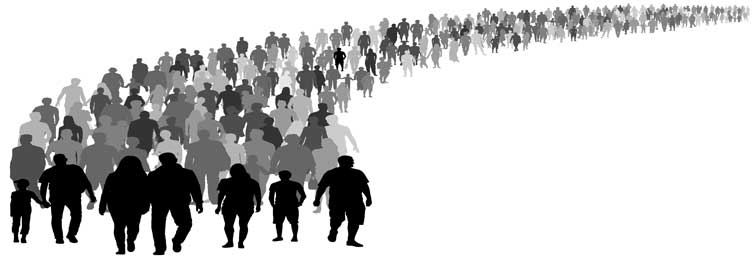
Climate Change, Migration and National Security
- Edwin S. Rubenstein
- August 11, 2020
- Forum Papers
- Forum Paper
- 1 Comment
Click here for a downloadable, printable PDF version.
CLIMATE CHANGE, MIGRATION AND NATIONAL SECURITY
An NPG Forum Paper
by Edwin S. Rubenstein
August 2020
As climate change accelerates, as much as one-third of world population could live in places that most humans consider too hot for habitation. Currently fewer than 25 million people, predominantly in Africa, live in these hot zones, defined as places where mean annual temperature (MAT) is above 84 degrees Fahrenheit.1 By comparison, Miami’s MAT is a comparatively “frigid” 74 F.
Research released in May finds that by 2070 hot zones could encompass a much larger part of Africa, as well as parts of India, the Middle East, South America, Southeast Asia, and Australia. As many as 3.5 billion people could live in these areas, according to Timothy A. Kohler, an archeologist at Washington State University, and lead author of the study which was published in Proceedings of the National Academy of Sciences. The parts of the world that could become unsuitably hot “…are precisely the same parts that are growing the fastest,” Kohler says.
The 3.5 billion figure is far higher than most estimates of the world population that will face the most dire aspects of climate change. A 2018 World Bank study, for example, estimates that about 140 million people may become climate migrants by 2050.
As an archeologist, Kohler’s time horizon extends over the totality of man’s existence: “We mine the massive sets of demographic, land use, and climate information that have become available in recent years to ask what the climatic conditions for human life have been across the past millennia, and then examine where those conditions are projected to occur in the future.”
Two of Kohler’s findings are particularly interesting. First, humans living today reside in pretty much the same “narrow subset” of Earth’s temperatures – about 50 to 60 degrees Fahrenheit – that human settlements did 6,000 years ago. “We didn’t think that would be the case,” another of the study’s authors, Martin Scheffer, a professor of complex systems sciences at Wageningen University in the Netherlands, says, because advances in clothing and technologies like air conditioning and crop irrigation have enabled people to populate areas with much broader temperature ranges.
(Memo to Professor Scheffer: The hottest region on Earth – Sub-Saharan Africa – is also home to some of the poorest and most rapidly growing populations on the planet. More impoverished people fighting for less water and arable land leaves modern technology and conveniences out of reach for all but the privileged few.)
Second, and more troubling, is Kohler’s prognosis for the future: “We show that in a business as usual climate change scenario” the geographical area in which humans will find temperatures to their liking (i.e., the 50 to 60 degree Fahrenheit range, dubbed “the human climate niche” by Kohler’s group) “… is projected to shift more over the coming 50y than it has over the past 6,000… [I]n the absence of migration, one third of the global population is projected to experience a MAT [above 84 degrees F.] currently found in only 0.8% of the Earth’s land surface… Continue reading the full Forum paper by clicking here.
Ed Rubenstein, president of ESR Research, is an experienced business researcher, financial analyst, and economics journalist. He has written extensively on federal tax policy, government waste, the Reagan legacy, and – most recently – on immigration. He is the author of two books: The Right Data (1994) and From the Empire State to the Vampire State: New York in a Downward Transition (with Herbert London). His essays on public policy have appeared in The Wall Street Journal, The New York Times, Harvard Business Review, Investor’s Business Daily, Newsday, and National Review. His TV appearances include Firing Line, Bill Moyers, McNeil-Lehr, CNBC, and Debates-Debates. Mr. Rubenstein has a B.A. from Johns Hopkins and a graduate degree in economics from Columbia University.



Donna Cathcart
Business want growth , more people to buy things. In the last some fifty years that has been considered a good thing. Quality of life in America has declined because of this.